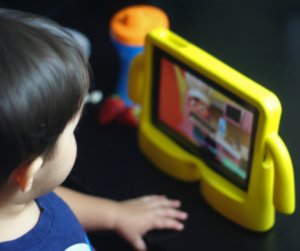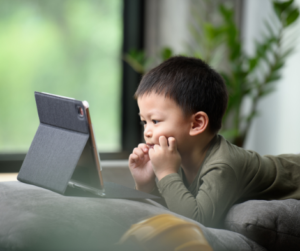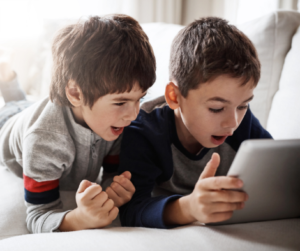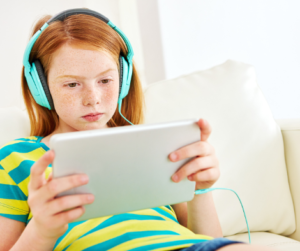I know there are tons of debates about screen time. Is it safe? How much is too much? What is okay and what isn’t? As a parent, it feels like a huge debate with no winners.
Today I am going to share what I have done as a parent, and why. Before we get started, I am going to tell you, I consider myself to be middle of the road on this one. I believe in age-appropriate limits, but we do allow screen time.
Birth to Age 2
 In an ideal world, I don’t think babies should watch screens. Babies need the real-life interaction they get from real people and real life. That said, my first born watched some baby videos.
In an ideal world, I don’t think babies should watch screens. Babies need the real-life interaction they get from real people and real life. That said, my first born watched some baby videos.
My oldest was a high-needs baby, that never wanted to be put down, and needed constant stimulation. This baby was not able to self-soothe and could cry for 4-5 hours straight. So, yes, there were times the baby sat in a bouncy seat in front of a baby-appropriate video with music and toys so that I could eat or get dressed. By age 1, we had graduated to Sesame Street and some preschool shows. My own goal was no more than 1 hour a day of TV at this stage.
One rule I did follow, was that we stopped watching the news on TV after the birth of our first child. I did not want my kids to be scared by news of wars, murderers, or tragedies. Children under age 7 generally don’t have the ability to understand that things like war are far away. They can’t distinguish between real risks and danger and what they see on TV. So, my husband and I switched to reading our news in newspapers or the internet. I have no regrets that we took this step to try to reduce the anxiety in our home.
Ages 2-5
 I am a believer that well-chosen preschool shows, in limited quantity, can be valuable. We limited TV time to 1-2 hours per day at this stage, and they were only allowed educational, age-appropriate preschool programming. Would no TV time be even better? Maybe for the kids, but TV time helped with my sanity.
I am a believer that well-chosen preschool shows, in limited quantity, can be valuable. We limited TV time to 1-2 hours per day at this stage, and they were only allowed educational, age-appropriate preschool programming. Would no TV time be even better? Maybe for the kids, but TV time helped with my sanity.
Like most stay-at-home moms of today, I didn’t have family or friends close by to drop my kids off with so that I could have a break. I had to create my own breaks. And I did not have children that could be left unsupervised and unoccupied. I used to say “My kids don’t get bored, they get into trouble.” And I would say that because it was cuter than explaining what it feels like to get out of the shower to discover your 2 and 4-year-olds have covered your couch, walls, and windows with Cool-Whip. It works great as a textured finger paint!
So, my kids generally got an hour of preschool TV in the morning when I was having breakfast and another hour in the evening when I was cooking dinner. We spent tons of time outside. We read books. We played with toys. And they had animated animals teaching them shapes and colors, numbers, and letters. Did they need that reinforcement? Probably not. But I did feel it was helpful for social situations for them to know who the characters were on the T-shirts of other kids we met.
Ages 6- 12
 Yes, I did think it was important that my kids know about pop culture for kids, so I let them watch popular shows that were age-appropriate. Knowing about popular shows gave them something to talk to other kids about. There was a phase where they really liked Disney Channel shows that featured kids in school. Did this lead to them asking to go to school? No. Interestingly, they thought school looked like a bad deal. They could tell the characters were happy when school was out. Those shows also portrayed enough issues with bullies and challenges, that my kids decided they didn’t want anything to do with that.
Yes, I did think it was important that my kids know about pop culture for kids, so I let them watch popular shows that were age-appropriate. Knowing about popular shows gave them something to talk to other kids about. There was a phase where they really liked Disney Channel shows that featured kids in school. Did this lead to them asking to go to school? No. Interestingly, they thought school looked like a bad deal. They could tell the characters were happy when school was out. Those shows also portrayed enough issues with bullies and challenges, that my kids decided they didn’t want anything to do with that.
During this phase of life, my kids often had days when they exceeded the 2 hours of screen time guideline. When I needed a sick day, Ms. Frizzle and her Magic School Bus made a great substitute teacher. I found educational movies and shows that taught tons of things. I also found that it was hard to teach 3 kids at 3 different levels every day. One solution was to let the kids rotate playing on a computer or iPad when it wasn’t their turn to work with me.
Was this ideal? Again, maybe not. But these were the same kids who “measured” how long a roll of duct tape was by taping around all the furniture in the entire house. Again, my sanity had to be worth something.
Our home computer during this phase, was in a public room that I walked through often on my way to do laundry or other tasks. I could not supervise every minute of screen time, but I made frequent checks and if I heard inappropriate language or content I felt wasn’t appropriate, I stepped in and turned it off or made them find something else to watch. I also talked to other moms to learn about YouTube channels that showed people playing Minecraft without swearing or other inappropriate things.
Ages 12 and Up
 In our home, we begin allowing kids to have personal computers in their rooms, along with items like phones at this age. That doesn’t mean I think it is appropriate for all kids at this age, but it works for our family. We have had lots of talks about internet safety. We have also discussed that what you watch, read, and play, gets to live in your head rent free. It is important to protect yourself from things that upset you.
In our home, we begin allowing kids to have personal computers in their rooms, along with items like phones at this age. That doesn’t mean I think it is appropriate for all kids at this age, but it works for our family. We have had lots of talks about internet safety. We have also discussed that what you watch, read, and play, gets to live in your head rent free. It is important to protect yourself from things that upset you.
I don’t watch horror movies because they upset me long after the movie is over. To this day, I can tell you the plot of the last “psychological thriller” I willingly watched. It was 20 years ago when I saw it. It just won’t go away. Discussing things like that with my kids, helps them make good decisions for themselves.
At this point, I am very liberal with my teens and their screen time. I understand that they interact with their real-life friends in games online. They use the internet to learn new things about their special interests. They explore art, music, and more.
All that said, none of my kids are very interested in social media. They probably use it less than I do. The one place they interact online is Discord, and they only talk to friends they know in person or friends of friends who have similar family rules to what we have. This means that if their friend made a friend at a homeschool park day and added that kid to a chat, my kids are allowed to talk to this new kid. But if no one knows the person in real life, they can’t chat with them.
I hope that by having the ability to set their own limits on screen time in high school, they will be ready to set those limits for themselves in adulthood. I recognize that as neurodiverse people, they may find comfort in screen time that helps them regulate their emotions. I also check in to make sure that screens haven’t taken over their lives and that they are still doing other activities like reading books and baking cookies.
Learning how to find your own balance is one of the blessings of homeschooling. Many kids don’t get a chance to find their own balance until college, but we can do it earlier. Hopefully, that means they are more prepared for the stage of life where I’m no longer in charge.


 Laura Sowdon, OTR/L is an occupational therapist, writer, speaker, educator, and creator of the Five Senses Literature Lessons homeschool curriculum. She has worked as an occupational therapist with children in public and private schools, as well as private practice. Laura has taught and managed homeschool co-ops as well as homeschooling her own three children. Laura is dedicated to the idea of educating children at a pace that aligns with brain and physical development milestones and respects neurodiversity in all its forms.
Laura Sowdon, OTR/L is an occupational therapist, writer, speaker, educator, and creator of the Five Senses Literature Lessons homeschool curriculum. She has worked as an occupational therapist with children in public and private schools, as well as private practice. Laura has taught and managed homeschool co-ops as well as homeschooling her own three children. Laura is dedicated to the idea of educating children at a pace that aligns with brain and physical development milestones and respects neurodiversity in all its forms.


